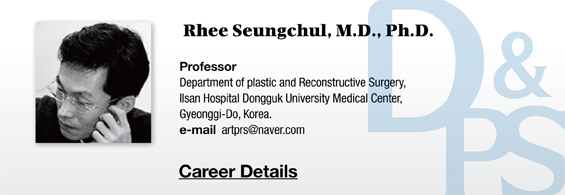
Dr. Seung-chul Rhee, Professor of Plastic Surgery, Dongguk University Ilsan Hospital, is leading the discussions on the aesthetics of the face in the field of aesthetic plastic surgery. He has authored a D&PS series on aesthetic standards and facial anthropometrics and continues to present lectures and writings on important concepts of aesthetics. D&PS is starting another series on Beauty Aesthetics by Dr. Rhee where he will share with our readers the findings of his research. We will get back to our discussion on what makes a beautiful face, review past discussions and suggest new concepts of beauty aesthetics.
I have written a few articles titled Beauty Aesthetics for D&PS. My past articles called for reevaluating our fixed notions of a beautiful face and presented my thoughts on aesthetic standards of different areas of the face. In this new series, titled ‘Beauty Aesthetics II: Breaking Stereotypes,’ we will review prominent theories on facial aesthetics and reestablish aesthetic standards that better reflect modern trends and expectations. Before we begin our new discussions, I thought it would help to first briefly review key points of the previous series.
What is a Beautiful Face?
Since the ancient times, many philosophers, mathematicians, plastic surgeons, psychologists, and aesthetics scholars have tried to answer this fundamental question. And facial beauty has been extensively studied in the fields of science, philosophy, mathematics, and socio-cultural research. Research on aesthetic principles so far focused on details of aesthetic units of the human face as well as ideal characteristics. Scholars seemed to agree that the overall balance between smaller units of the face is more important to facial attractiveness than ideal characteristics of an individual unit. Such analysis and explorations of facial aesthetics contributed greatly to the advancement of cosmetic surgery. These principles can be quantified in mathematical values and measurements.
[Advertisement] PICOCARE - Manufacturer: WONTECH(www.wtlaser.com)
As I have mentioned already in the previous articles, certain fixed notions of what constitutes an attractive face have been spread by media and propagated through the society, leading to undesired consequences. For example, in the Western culture, there is an obsession with large hips, breast, and thick lips. In Korea, there is an unhealthy preference of large eyes and a narrow face line. In Western countries, there are an increasing number of deaths related to hip augmentation surgery and in Asian countries, aggressive canthoplasty carried out for enlarging the eye opening has resulted in many complications. Other complications include the unnatural, expressionless face resulting from excessive injectable treatments and disproportionately narrow lower face or chin, etc.
As certain concepts of beauty that are blindly followed are causing undesired social phenomena, people are starting to realize that what is considered beautiful differs across races, ethnicities and generations. Aesthetic surgeons should understand such differences, ever-changing beauty trends of today and keep abreast with current research. Especially, in this globalized world where an aesthetic surgeon is likely to see patients from different parts of the world who have uniquely different demands, she or he needs to be able to understand the various standards of beauty across races and cultures and deliver results that each patient is expecting.
Therefore, an aesthetic surgeon should not insist on their own thoughts on beauty, avoid using the same techniques in different patients and be able to quantify and standardize current preferences of the public when it comes to facial aesthetics. They need to not only be able to live up to the expectation but guide their patients away from unhealthy preferences as well. Aesthetic clinicians will not be able to fully satisfy their patients if they fail to evolve from their own fixed notions and adhere to a one-size-fits-all method.
-To be continued




















